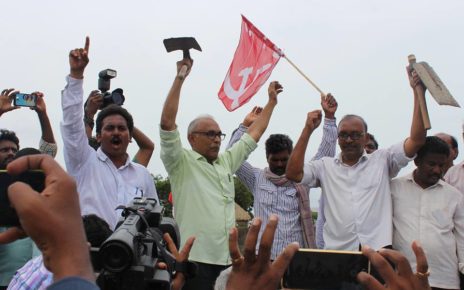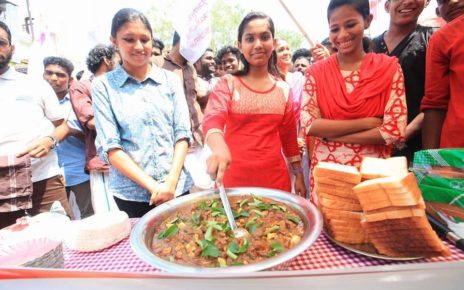(Published in People’s Democracy, December 10, 2006)
December 6, 2006 marked the 50th death anniversary of Dr Babasaheb Ambedkar, the indefatigable champion of those who have been socially oppressed for centuries in our vast land. Like every year, but in even greater numbers this year, lakhs of people from all over the country, and also from abroad, converged that day at the Chaitya Bhoomi at Dadar in Mumbai to pay homage to this indomitable fighter for social justice who passed away 50 years ago in 1956.
October 2, 2006, Dussehra day, marked the 50th anniversary of Dr Ambedkar’s conversion to Buddhism, after a lifetime spent in unsuccessfully trying to reform Hinduism and its rigid and monstrous caste structure. Lakhs of people from all over gathered at the Deeksha Bhoomi at Nagpur on that day to observe that historic anniversary too. By his conversion in 1956, Dr Ambedkar, towards the end of his life, fulfilled a vow he had made two decades earlier when, after criticising the inegalitarian social structure inherent in Hinduism, he had said that although he had been born a Hindu, he would not die a Hindu!
Just three days before that Nagpur event, on September 29, 2006, took place the horrific massacre of a dalit family at Khairlanji in Bhandara district near Nagpur. It is indeed a shocking irony that such a heinous incident, which recalls dark memories of the Kilvenmani dalit massacre in Tamil Nadu nearly four decades ago, should occur in a state that has had a long and rich tradition of great social reformers like Mahatma Jotirao Phule, Chhatrapati Shahu and Dr Ambedkar – that too in a year that marks the half century of Dr Ambedkar’s conversion and demise.
Certain aspects of the Khairlanji massacre have now become very clear. The Bhotmange family was being socially and economically harassed by the upper caste landed interests in the village for a number of years. Whatever little land they had was also sought to be taken away from them. That was the immediate cause of the massacre. The mother and daughter, before being mercilessly lynched, were paraded naked and then gang-raped. The two sons were mutilated and killed. The Khairlanji massacre thus represented a condemnable case of caste, gender and class atrocity.
Khairlanji village is dominated by the BJP. The local MLA and MP of the area also belong to the BJP. None of these elected representatives lifted a finger for the last two months after the massacre. This throws blinding light on the true nature of the BJP, which often hypocritically shouts from the rooftops about social justice. With such a background, the long speeches made by BJP leaders Gopinath Munde and Nitin Gadkari in the state legislature were nothing but plain crocodile tears. There is also some evidence to indicate that the BJP, and also the NCP, are cynically using this massacre to drive a further wedge between dalits and non-dalits, in order to achieve consolidation of the upper castes on the eve of the statewide local body elections that are scheduled for February 2007.
The role of the Congress-NCP state government in handling this entire tragedy has few parallels and needs to be squarely denounced. Instead of vigorously taking up the case with the utmost seriousness and initiating the most stringent action against the inhuman culprits who perpetrated this massacre and also against the casteist police and medical officials who furnished false evidence, the state government just sat tight on the matter for weeks. It was only after the militant dalit uproar in Nagpur in early November that the government took some half-hearted steps.
The deputy chief minister and home minister R R Patil of the NCP, by repeatedly insinuating that Naxalites are behind the spontaneous dalit upsurge, was in effect giving a signal to the police to deal harshly with all mass protests against the Khairlanji massacre. The police took the cue and did the needful. In several places in the state, the police refused permission to hold any protest demonstrations at all. Wherever they were held, they were met with police violence or harassment. The height of this high-handedness was reached on December 4, on the first day of the state assembly session at Nagpur, when the city was virtually turned into a police camp to repress the huge protest rally and public meeting that were planned there.
It was against this entire background that the desecration of Dr Ambedkar’s statue at Kanpur proved to be the proverbial last straw for the incensed dalit populace in Maharashtra. Most of the actions that took place over two days in various parts of Maharashtra were a spontaneous and combined reaction to the Khairlanji massacre, the government’s inaction and the Kanpur desecration. However, some violent incidents like the burning of the Deccan Queen at Ulhasnagar appear to be pre-planned and may have been instigated by anti-social elements.
With some honourable exceptions, large sections of the press and the media tried to suppress the Khairlanji massacre in large parts of Maharashtra and in the country as a whole. This needs to be probed in detail.
The visit of CPI(M) Polit Bureau member Brinda Karat, MP, to Nagpur and Khairlanji and her press conference at Nagpur on November 9 had a salutary effect. The follow-up that she conducted with the prime minister and the union home minister was instrumental in the CBI inquiry that has now been ordered.
The CPI(M) Maharashtra state committee gave a call for immediate statewide protest demonstrations to condemn the Khairlanji massacre. Accordingly, the Party took the lead in several districts and organised large independent or joint actions, sometimes in violation of ban orders. In all the 10 AIKS jathas that coursed through most of the districts of Maharashtra in November before the AIKS Delhi Rally, the Khairlanji massacre and the state government inaction was roundly condemned in all the public meetings.
However, much more needs to be done to prevent such heinous caste atrocities and also the efforts by vested interests to splinter peoples’ unity and create caste polarisation in their wake. This will be discussed in depth in the CPI(M) state committee meeting that will be held by the end of this month.

